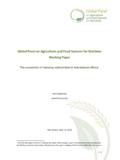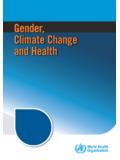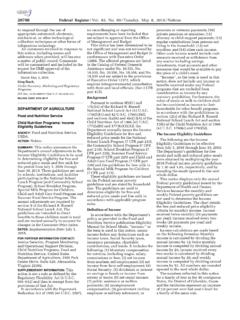Transcription of Chapter 5
1 SummaryResearch conducted during the past 10 15 years suggests that zinc defi-ciency is widespread and affects the health and well-being of populationsworldwide. The objective of this Chapter is to quantify the regional andglobal magnitude, distribution and disease burden implications of conducted a systematic literature search to identify relevant studiesinvestigating the role of zinc in human health. This search indicated thatevidence on the burden of disease related to zinc deficiency would belimited to the results of randomized controlled trials (RCTs) conductedamong paediatric populations in developing countries, and wouldprovide information on whether zinc deficiency affects the incidence ofdiarrhoea, pneumonia and malaria illness among children aged 0 4years.
2 There are no global estimates of zinc deficiency in paediatric orother populations; however, the International Zinc Nutrition Consulta-tive Group (IZiNCG) has developed a method for estimating the preva-lence of inadequate zinc intakes based on the presence and bioavailabilityof zinc in each country s food systematic review of relevant epidemiological research involvedmeta-analysis from 11 intervention trials. Results of our review indicatethat zinc deficiency in children aged <5 years increases the risk of inci-dence for diarrhoeal disease by (95% CI ), pneumonia (95% CI ) and malaria by (95% CI ). Weextended those results as best estimates of the risk of mortality fromthese causes as a result of zinc deficiency.
3 Following the IZiNCG tech-nique, the global prevalence of zinc deficiency was estimated at 31%,ranging from 4 73% across on these estimates, zincdeficiency was estimated to cause 176 000 diarrhoea deaths, 406 000pneumonia deaths and 207 000 malaria deaths. The associated loss ofdisability-adjusted life years (DALYs) attributable to zinc deficiencyamounts to more than 28 million. The burden of disease due to zinc Chapter 5 Zinc deficiencyLaura E. Caulfield and Robert E. Blackdeficiency is borne most heavily by countries in Africa, the EasternMediterranean and South-East Asia. The burden was approximatelyequally shared between males and results of this review suggest that zinc deficiency contributes sub-stantially to the morbidity and mortality of young children throughoutthe world.
4 Available evidence from RCTs on the strength of the associ-ation between zinc deficiency and morbidity from diarrhoea, pneumoniaand malaria, combined with the high estimated prevalences of inade-quate zinc diets, translates into a significant burden of disease attribut-able to deficiency of this micronutrient. Evidence relating zinc deficiencyto health outcomes in children aged >5 years and adult men and womenwas not available. Given the likely high prevalence of inadequate zincintakes in these other groups, research is needed to determine the mag-nitude of the potential health is a trace mineral essential to all forms of life because of its fun-damental role in gene expression, cell development and replication(Hambridge 2000).
5 Severe or clinical zinc deficiency was defined lastcentury, as a condition characterized by short stature, hypogonadism,impaired immune function, skin disorders, cognitive dysfunction andanorexia (Prasad 1991). Although severe zinc deficiency is consideredrare, mild-to-moderate zinc deficiency is likely prevalent throughout theworld today (Sandstead 1991). Lack of consensus on indicators of zincdeficiency has hampered efforts to document prevalences of zinc defi-ciency. Despite this, RCTs of zinc supplementation in areas with habit-ual low zinc intakes have begun to demonstrate how low dietary intakesof zinc adversely affect child health (Brown et al. 1998a; Zinc Investi-gators Collaborative Group 1999, 2000).
6 For this reason, it is impor-tant to attempt to quantify the prevalence of zinc deficiency and itscontribution to the global burden of disease. The goal of this Chapter isto describe the methods used to quantify the magnitude, distribution anddisease burden implications of zinc and definition of the risk factorMillions of people throughout the world may have inadequate levels ofzinc in the diet due to limited access to zinc-rich foods (animal products,oysters and shellfish) and the abundance of zinc inhibitors, such as phy-tates, common in plant-based diets (Sandstead 1991). Our understand-ing of the public health importance of inadequate zinc intakes has beenhampered by a lack of indicators of zinc status for identifying individualswith zinc deficiency (Wood 2000).
7 Estimating the prevalence of zinc deficiency is difficult because plasmaor serum zinc concentrations, the most widely used indicators of zinc258 Comparative Quantification of Health Risksdeficiency at the population level, have not been assessed in national orregional surveys in developing countries. Even in developed countries,such indicators are not used for methodological and cost deficiency is largely related to inadequate intake or absorptionof zinc from the diet, although excess losses of zinc during diarrhoeamay also contribute (Gibson 1994; WHO 1996). The distinctionbetween intake and absorption is important, because although someintakes of zinc may be acceptable, the levels of inhibitors ( fibre andphytates) in the diet may mean that inadequate amounts of zinc areabsorbed.
8 For this reason, zinc requirements for dietary intake areadjusted upward for populations in which animal products, the bestsources of zinc, are limited, and in which plant sources of zinc are sim-ilarly high in phytates. Because zinc is not well conserved in the bodyand because zinc deficiency is directly related to dietary zinc intake, anindirect approach to quantify the prevalence of zinc deficiency would beto examine the adequacy of zinc in the diet in various regions through-out the surveys are conducted in many countries, but few such surveysexist in developing countries (Gibson 1994; Parr 1992; WHO 1996).Even when dietary intake data are available, incomplete information onthe content of zinc and its bioavailability in local foods has made cal-culation of zinc bioavailability of zinc deficiencySeveral alternative approaches have been taken to estimate the adequacyof the diet in various regions of the world.
9 For example, the WorldHealth Organization (WHO) (1996) used a factorial approach to esti-mate the average basal and normative zinc requirements ( minimumamount of zinc to cover losses in individuals adapted or not adapted tolow usual dietary intakes of zinc) for population subgroups, and thenconsidered issues of zinc bioavailability from the typical diet in variousregions of the world to derive estimates of the minimal dietary intake ofzinc that would meet these requirements. They then compared the esti-mated dietary intakes of zinc from 210 dietary surveys conductedthroughout the world as a percentage of the minimal dietary intake ofzinc, and identified surveys in which the mean intake of zinc did not meetthe minimal basal or normative level of intake.
10 Overall, this method ledto the conclusion that populations with inadequate intakes of zinc werelikely widespread throughout the world, but concentrated in areas of theworld consuming plant-based diets in which zinc was only of low tomoderate bioavailability. For example, of 148 surveys conducted in pop-ulations with presumed highly bioavailable zinc (mostly western Europeand the United States of America), only one dietary survey indicated amean intake lower than the minimal zinc intake to meet average nor-mative requirements for zinc. In contrast, among 47 surveys conductedin populations with moderate zinc bioavailability, 40 indicated averageLaura E. Caulfield and Robert E. Black259intakes lower than the minimal normative zinc intake, and of 15 surveysconducted in populations with low zinc bioavailability, none reportedmean intakes greater than the minimal normative zinc intake.















